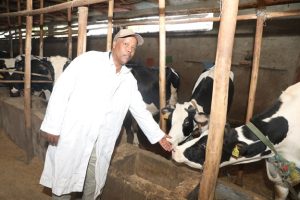
BY STAFF REPORTER
It was about five years ago that for the first time in history, more than 50 percent of the world’s population now lives in towns and cities, according to FAO. By 2050, this number is expected to increase to 66 percent. The shift from rural to urban areas, mainly in Africa and Asia, is due to poverty and related socio-economic factors.
Globally, emissions from buildings and construction are growing and reached an all-time high in 2019 of around 10 GtCO2. As yet, energy efficiency improvements and other technological developments have not been enough to offset increases in emissions due to growth in the sector.
Occupants’ choices and behaviours play a key role in how buildings and technologies within them are used, and energy consumed. Certain behaviours can lead to increased energy demand such as opening windows when heating/cooling systems are on or forgetting to switch off appliances (e.g. lights) or heating/cooling systems when they are not in use. This can result in a substantial waste of energy from homes and commercial buildings.
For the most part, the rapid expansion of cities takes place without any land use planning strategy and the resulting human pressure has highly damaging effects on forests, landscapes, as well as green areas in and around cities. The environmental impacts of urbanization are often intensified by climate change and include increased pollution, decreased availability of food and resources, as well as increased poverty and frequency of extreme climatic events.
With a population of more than a hundred million Ethiopia is also one of the countries in the world as well as in Africa that is showing rapid growth in urbanization and rural urban migration. This calls for an overall effort to make the cities more livable for such growing number of population.
Currently various technologies are applied in different countries to reduce green house gas in urban areas. But these technologies need financing and time to apply in developing countries like Ethiopia. Hence the other option, expanding forestry in urban areas becomes handier.
Urban trees can help to mitigate some of the negative impacts and social consequences of urbanization, and thus make cities more resilient to these changes. Here are nine ways in which urban trees and forests contribute to making cities socio-economically and environmentally more sustainable:
Urban green spaces, particularly trees, have great potential to sequester carbon from the atmosphere and mitigate the impacts of climate change in cities. Large university campuses offer prominent space where such green spaces can be developed in order to offset the increasing greenhouse gas emissions, as well as other benefits. Amity University, Noida, is spread over 60 acres with dense tree plantations in and around the campus. The present study is a sustainability initiative to inventory the tree species on the campus and assess their total carbon sequestration potential (CSP).
The above- and below-ground biomasses were estimated using the non-destructive sampling method. Individual trees on the campus were measured for their height and diameter at breast height (DBH), and estimates of carbon storage were performed using allometric equations. There is a total of 45 different tree species on the campus with the total CSP equivalent to approximately 139.86 tons. The results also reveal that Ficus benjamina was the predominant species on the campus with CSP equivalent to 30.53 tons, followed by Alstonia scholaris with carbon storage of 16.38 tons.
The study reports that the ratio of native to exotic species is 22:23 or almost 1:1. The present work highlights the role of urban forests or urban green spaces, not only as ornamental and aesthetic plantations but also in mitigating the impacts of climate change at a local level. Higher education institutes have an important role in expanding their green cover so as to act as local carbon sinks.
Planting trees has quickly emerged as a seemingly simple way to soak up carbon emissions. Everybody likes it: Environmentalists, politicians, and corporations alike are pushing for a rapid expansion of reforestation efforts to help meet climate goals.
This means growing trees—and lots of them—with the expectation that they’ll capture and store carbon dioxide and help prevent it from warming the world beyond the Paris Agreement target of 3.6 degrees Fahrenheit (2 degrees Celsius) above pre-industrial temperatures.
But according to a new study in the journal Frontiers in Forests and Global Change, there aren’t enough tree seedlings currently being grown, at least in the United States, to keep up with those goals. If reforestation efforts are to help tackle climate change, the study finds, tree nurseries across the U.S. will have to increase their production to at least three billion seedlings per year— more than double current levels.
This needs to happen “sooner than later,” said the study’s lead author, Joe Fargione, science director for The Nature Conservancy’s North America Region.
“You can’t plant a tree until you grow it. And you can’t grow it in the nursery until you have the seed.”
In order to better understand how to increase national tree production levels, Fargione and over a dozen other researchers surveyed 181 federal, state, and private nurseries and foresters last year, representing at least half of all seedling production in the U.S.
The results, released last month, show that the nation’s nurseries are currently producing 1.3 billion seedlings per year, which are mostly going to replace existing trees harvested by timber companies or lost to wildfires. To expand U.S. forests onto an additional 64 million acres identified by the study as ripe for reforestation—and carbon storage—would take another 1.7 billion seedlings a year. That brings the total needed from nurseries to three billion a year, more than a 130 percent increase.
Ramping up seedling production that much, and making sure they live long enough to trap enough carbon emissions, will cost tens of billions of dollars, according to the study. It will require training specialized seed collectors and investing in new infrastructure, as well as bolstering long-term monitoring to ensure forests survive in the face of pests, disease, drought, and wildfires-threats that are all on the rise because of climate change.
AS can be recalled the government of Ethiopia has been streamlining the plantation of billions of seedlings in urban areas since the last three years. Accordingly people from all walks of life have participated in the plantation of seedlings in all corners of the country. The successful sprouting of the seedlings is expected to bring about drastic contribution towards reducing the greenhouse gas emission in all corners of the country.
The Ethiopian Herald August 19/2021




